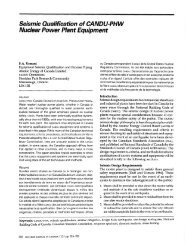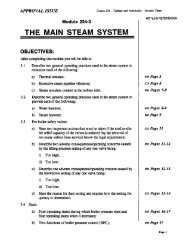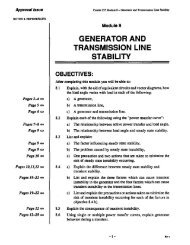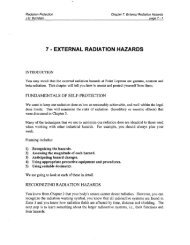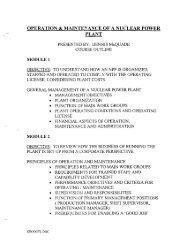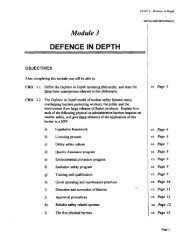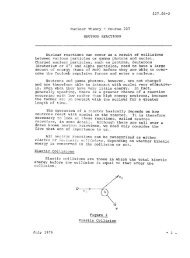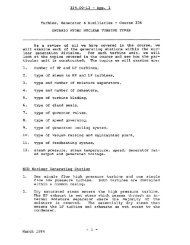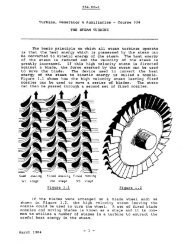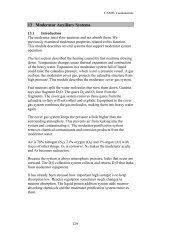You also want an ePaper? Increase the reach of your titles
YUMPU automatically turns print PDFs into web optimized ePapers that Google loves.
Note: Errata has been applied to this electronic document<br />
1
CANADIAN POWER REACTOR FUEL<br />
by<br />
R.D.Page<br />
ATOMIC ENERGY OF CANADA LIMITED<br />
Power Projects<br />
Sheridan Park Research Community<br />
Mississauga, Ontario, L5K 182<br />
March 1976
CANADIAN POWER REACTOR FUEL<br />
by R.D. Page<br />
ABSTRACT<br />
This paper is intended to introduce the reader to Canada's power reactor<br />
fuel. It was originally written as part of a lecture series to introduce nuclear<br />
power to other utilities and customers not presently involved with the<br />
CANDU system. It has since been updated and presented in many forms.<br />
This recent revision brings it up to date to March 1976.<br />
The paper covers the following broad subjects:<br />
a The basic CANDU fuel design.<br />
b The history of the bundle design<br />
c The significant differences between CANDU* and LWR+ fuel<br />
d Bundle manufacture<br />
e Fissile and structural materials and coolants used in the CANDU fuel program<br />
f Fuel and material behaviour, and performance under irradiation<br />
g Fuel physics and management<br />
h Booster rods and reactivity mechanisms ,<br />
Fuel procurement, organization and industry<br />
j Fuel costs<br />
k Summary<br />
* CANDU - Canadian Deuterium Uranium Reactor<br />
+ LWR - Light Water Reactor<br />
ATOMIC ENERGY OF CANADA LIMITED<br />
Power Projects<br />
Sheridan Park Research Community<br />
Mississauga, Ontario, L5 K 1B2<br />
AECL 5609 March 1976
INDEX<br />
Section Page<br />
1 Introduction 1<br />
2 Fuel Design 1<br />
3 Design and Development History 1<br />
3.1 Pressurized Heavy Water Fuel - PHW<br />
3.2 Boiling Light Water Fuel - BLW<br />
3.3 Boiling Heavy Water - BHW<br />
3.4 Geometric Cross Sections<br />
4 Differences between CANDU and LWR 7<br />
5 Fuel Manufacture 9<br />
6 Fissile, Structural Materials and Coolants 18<br />
6.1 Fissile Materials<br />
6.2 Structural Material<br />
6.3 Coolants<br />
7 Fuel Performance and Material Behaviour 20<br />
7.1 Uranium Dioxide<br />
7.1.1 Thermal Conductivity<br />
7.1.2 Radiation-I nduced Swelling<br />
7.1.3 Gas Release<br />
7.2 Zircaloy<br />
7.2.1 Irradiation or Fast Neutron Damage<br />
7.2.2 Corrosion and Hydrogen Pick-up<br />
7.2.3 Stress Corrosion Cracking<br />
7.3 Fuel Element<br />
7.3.1 Sheath Collapse<br />
7.3.2 Element Thermal Expansion<br />
7.3.3 Fission Gas Pressure<br />
7.3.4 Hydraulic and Fuelling Machine Loads<br />
7.4 Fuel Handling System<br />
7.5 Fuel Bundle Testing<br />
7.5.1 Out-reactor Tests<br />
7.5.2 Irradiation Testing<br />
7.5.3 Pressure and Temperature Cycles<br />
7.5.4 Power Cycles<br />
7.6 Fuel Bundle Performance<br />
7.6.1 Statistics of Fuel Bundle Performance<br />
7.6.2 Defect Mechanisms<br />
7.6.3 Fuel Performance Criterion<br />
7.7 Bundle and Element Behaviour Under Extreme Conditions<br />
7.7.1 Gross Overpower<br />
7.7.2 Dryout<br />
8 Fuel Physics and Management 42<br />
8.1 Fuel Bundle and Core Flux Distributions<br />
8.2 Reactivity Mechanisms and Booster Rods<br />
9 Fuel Procurement 45<br />
10 Fuel Industry 45<br />
11 Fuel Costs 47<br />
12 Potential for Future Development 52<br />
13 Summary 52
Figure No. TITLE Page<br />
Fuel Bundle for Pickering Reactor Assembled from Seven Basic Components 2<br />
2a Bruce 37-Element Bundle 3<br />
2b 600 MWe 37-Element Gentilly-2 Fuel Bundle 3<br />
3 Fuel Bundle Cross Sections 5<br />
4a Fuels for Canada's Power Reactors 6<br />
8 cm Bundles NPD, Douglas Point<br />
4b Fuels for Canada's Power Reactors, 10 cm Bundles, 6<br />
Pickering, Gentilly-1, Bruce and Gentilly-2<br />
5 Natural Uranium Cycle 8<br />
6 Enriched Uranium Cycle 8<br />
7 NPD and Douglas Point Wire Wrap Spacing and Bundle Construction 9<br />
8 Cross Section through Closure Weld 9<br />
9 Cross Section of Bundle Assembly Weld 10<br />
10 Split Spacer Design 10<br />
11 Close-up of Brazed Split Spacer and Bearing Pad 11<br />
12 Cross Section of Brazed Spacer 11<br />
13 Pictorial Process Steps in the Natural Uranium Fuel Cycle 12<br />
14 Split Spacer Bundle Manufacturing Steps 13<br />
15 U02 Production 14<br />
16 Fuel Bundle Production Stage 1 15<br />
17 Fuel Bundle Production Stage 2 16<br />
18 Fuel Bundle Assembly 17<br />
19 Typical Transverse Cross Section of Irradiated U02 at<br />
Four Power Ratings showing Pellet Cracks and U02 Grain Growth<br />
21<br />
20 Percent Fission Gas Release versus U02 Power Rating 22<br />
21 Influence of Cold Work as represented by the Axial Ultimate<br />
Tensile Strength on Circumferential Elongation in the Closed-End Burst Test<br />
22<br />
22 Effect of Oxygen on the In-reactor Corrosion of Zircaloy, 270-300oC 23<br />
23 Deuterium Pickup of NPD Sheathing 24<br />
24 Cross Section of Fuel Element showing Zr Hydride Damage 24<br />
25 Stress Corrosion Cracking 25<br />
26a Pellet Interface Circumferential Strains Measured with<br />
Resistance Strain Gauges during the First Power Cycle<br />
(two different tests) compared with Calculated Expansions<br />
26<br />
26b Mid Plane Circumferential Strains, ditto 26<br />
27 Fuel Sheath Interactions 27<br />
28 Pickering Fuel Handling System 29<br />
29 . Bruce Fuel Handling System 30<br />
30 600 MWe Reactor Fuel Handling System 31<br />
31 Pickering Fuelling Machine 31<br />
32 Douglas Point Fuelling Machine 32<br />
33 Example of Douglas Point Defect 35<br />
34 Defect Mechanisms 36<br />
35 Stress Corrosion Cracking Model 37
INTRODUCTION<br />
In Canada the development of power-reactor fuels began approximately twenty years ago<br />
with the design and manufacture of the first charge for the demonstration power reactor,<br />
NPD*. Early successes are attributed to a deliberate policy of cooperation between Atomic<br />
Energy of Canada Limited and private industry. In subsequent years, as the designs were<br />
improved and more fuel was manufactured, both the AECL laboratories and private industry<br />
grew in maturity. A division of responsibility evolved whereby manufacturing and design<br />
know-how became entrusted to private industry, while the AECL laboratories concentrated<br />
on fundamental studies related to more advanced applications. At the same time fuel<br />
management techniques were developed by the Hydro-Electric Power Commission of Ontario+,<br />
the principal customer for nuclear fuel in Canada. Thus, through long-term planning and<br />
investment in people and facilities, Canada has built a strong integrated capability for<br />
research, development, manufacturing and use of nuclear fuel.<br />
From the beginning, the objective has been to develop power-reactor fuels that are reliable<br />
and inexpensive, and have low parasitic absorption. To achieve this objective, the fuel has<br />
been kept as simple as possible. The bundle consists of only the fuel material and a<br />
minimum containment envelope; all related but non-consumable components - such as<br />
channels, orifices, control and monitoring equipment, and fuel-handling hardware - are<br />
kept as part of the reactor capital equipment. Fabrication techniques are also simple and,<br />
whenever possible, are adapted from normal industrial practice. These techniques are susceptible<br />
to standardization and automation, and the number of different processes is<br />
minimized.<br />
2 FUEL DESIGN<br />
The Pickering bundle shown in Figure 1 is typical of the fuel designers' response to the<br />
objectives. It is a bundle of 28 closely packed elements, each containing high-density<br />
natural U02 in a thin (0.4 mm) Zircaloy sheath (ref. para. 6.2). Plates welded to the end of<br />
the elements hold them together; spacers brazed to the sheaths keep the desired separations.<br />
The bundle is approximately 50 cm long and 10 cm in diameter.<br />
The Pickering fuel bundle is 92 wt% U02; the 8 wt% Zircaloy is made up of the sheaths, endcaps,<br />
structural end-plates, and spacers. The structural material accounts for only 0.7% of<br />
the thermal neutron cross section of the bundles, to give a fuel assembly that is highly<br />
efficient in its use of neutrons. There are only seven different types of components in<br />
the 76,000 bundles produced to date for the 2,160 MW(e) gross Pickering Generating Station.<br />
Replacement Pickering fuel is identical to the original charge except for the addition of<br />
Canlub(para<br />
7.6.2).<br />
3 DESIGN AND DEVELOPMENT HISTORY<br />
3. Pressurized Heavy Water Fuel - PHW<br />
The design and development of fuel for the CANDU type reactors have been well documented<br />
(References 1 through 9): therefore it is only necessary to outline briefly the salient points.<br />
• NPD - Nuclear Power Demonstration<br />
+ "Ontario Hydro" is an electrical utility with 7,270 MW(e) of CANDU reactors (moderated and cooled with<br />
heavy water) in operation and under construction. .<br />
1
4 DIFFERENCES BETWEEN CANDU AND LWR<br />
The significant differences between CAN DU PHW fuel and that used in the LWR American<br />
enriched reactors are listed in Table II.<br />
LWR<br />
CANDU PHW LWR RATIO PHW<br />
Fissile Materials Natural U Enriched 3<br />
0.7% U235 1.5 - 3%<br />
Total Fuel Cost Low High 3 to 4<br />
Length (Element) Short Long 8<br />
Diameter (Element) Larger Smaller 0.7<br />
Sheath Thickness Thin Thick 1.45<br />
Diametral Gap Low High 2.3<br />
Complexity Simple Complex -<br />
U02 Density High Medium 0.98<br />
Spacing (Element) Small Large 2.7<br />
Fuelling On power Off power -<br />
TABLE" Differences between CANDU and L WR Fuel<br />
The significance of these differences in fuel design is difficult to summarize briefly without<br />
going into a detailed comparison between the two reactor systems and their fuel cycles <br />
PHW versus LWR. However, the following can be stated - enriched fuels are more expensive<br />
by a factor of lOin total fuel costs, resulting in a fuelling cost 2.5 times greater, when allowances<br />
are made for the higher burnup of the LWR.<br />
The major reason for this large difference in costs is the use of enrichment in the LWR<br />
reactor fuel cycle. The enriched uranium requires a number of added steps in the manufacturing<br />
flow sheet. Schematics of the natural and enriched uranium cycles are shown in<br />
Figures 5 and 6.<br />
The enriched fuel cycle relies on spent fuel reprocessing to recover the unused fissile<br />
uranium, and plutonium, which are credited to the fuel cycle costs.<br />
Even comparing the fabrication costs of the bundles only, the PHW fuel is approximately<br />
one-third the price of LWR fuel.<br />
It should be noted that because LWR fuel is full length, the whole assembly has to be discharged,<br />
if any part becomes defective. It is possible, with the short PHW fuel bundle and<br />
on-power fuelling, to reject only a small part of the defectivefuel in the channel.<br />
The simple CANDU natural uranium cycle contributes only a small amount to the cost of<br />
power e.g., approximately 1.0 mills/kWh (1976) for Pickering reactors.
12<br />
ZIRCONIUM ALLOY<br />
PRODUCTION<br />
ZIRCONIUM<br />
TUBE<br />
MANUFACTURE<br />
FUEL BUNDLE ASSEMBLY<br />
REACTOR<br />
URANIUM MINING AND MILLING<br />
FIGURE 13 Pictorial Process Steps in the Natural Uranium Fuel Cycle<br />
U0 2 PELLETIZING<br />
U0 2<br />
REFINING<br />
SPENT FUEL STORAGE BAY
ZI RCALOY STRIP<br />
•<br />
INSPECT<br />
•<br />
PREPARE SURFACE<br />
•<br />
COAT WITH BRAZE<br />
•<br />
MATERIAL<br />
•<br />
INSPECT<br />
•<br />
FORM WEAR PADS<br />
& SPACERS<br />
•<br />
INSPECT<br />
ZI RCALOY BAR<br />
INSPECT<br />
•<br />
FORM END CAPS<br />
•<br />
RINSE<br />
•<br />
INSPECT<br />
FIGURE 14 Split Spacer Bundle Manufacturing Steps<br />
ZIRCALOY TUBING<br />
INSPECT<br />
MACHINE ENDS<br />
& INSPECT<br />
DEGREASE<br />
'.<br />
TACK WELD APPENDAGES<br />
BRAZE & INSPECT<br />
GRAPHITE COAT & INSPECT<br />
LOAD U0 2<br />
•<br />
CHECK END CLEARANCE<br />
WELD END CLOSURES<br />
MACHINE ENDS<br />
INSPECT FOR DIMENSIONS<br />
& LEAK TEST<br />
DEGREASE<br />
WELD BOTH END PLATES<br />
•<br />
INSPECT<br />
DEGREASE & FINAL INSPECT<br />
•<br />
PACKAGE<br />
U0 2 P
6.2 Structural Material<br />
The basic structural material used in the construction of fuel assemblies is Zircaloy-2 or -4.<br />
These are alloys of zirconium originally developed by the Americans for their naval reactor<br />
program to give low thermal neutron cross section and good corrosion resistance in i<br />
300 0 C water.<br />
Table IV indicates the alloying elements of Zircaloy-2 and -4.<br />
Zircaloy-2 Zircaloy-4<br />
Tin 1.20 - 1.70 wt% 1.20 - 1.70 wt%<br />
Iron 0.07 - 0.20 wt% 0.18 - 0.24 wt%<br />
Chromium 0.05 - 0.15 wt% 0.07 - 0.13 wt%<br />
Nickel 0.03 - 0.08 wt% -<br />
Total Fe + Cr + Ni 0.18 - 0.38 wt% 0.28 - 0.37 wt%<br />
Carbon 80- 300 ppm 80- 300 ppm<br />
Oxygen 900 - 1600 ppm 900 - 1600 ppm<br />
Zr + Permitted Impurities Balance Balance<br />
TA BLE I V Composition ofZircaloy-2 and 4<br />
The only differences between Zircaloy-2 and Zircaloy-4, are the deletion of nickel and the<br />
slight increase in iron in Zircaloy-4. Their behaviour as fuel sheathing is similar.<br />
All Canadian power reactor fuels in production today use Zircaloy-4. It has a slight<br />
corrosion and hydrogen pick-up performance advantage over Zircaloy-2 under our coolant<br />
conditions.<br />
6.3 Coolants<br />
The predominant coolant in Canada's program has been pressurized heavy water (PHW) and<br />
is used in NPD, Douglas Point, Pickering and Bruce. Boiling heavy water (BHW) was also<br />
used in NPD for two years as an experiment.<br />
The outer zone of the Bruce core has low net exit quality 3% and future reactors will have<br />
increasing qualities at exit from the channel, as the power density is increased with a constant<br />
inlet coolant temperature.<br />
The Gentilly reactor uses normal light water as a coolant and the reactor is designed to boil<br />
the water in the reactor (BLW). The average exit quality for the core is 16.5 wt% steam.<br />
Because organic coolants can be operated at higher temperatures than water while at lower<br />
pressures, they are being developed for future reactors. WR-1 test reactor at WN RE*,<br />
Manitoba, is cooled by this fluid (HB-40). This higher temperature of the coolant will<br />
allow higher overall station thermal efficiency. A comparable station would discharge about<br />
a third less heat through its condenser than a PHW per unit of energy generated. Due to<br />
* Whiteshell Nuclear Research Establishment<br />
19
22 32r---------------------------<br />
w<br />
(/)<br />
« 24<br />
w<br />
...J<br />
w<br />
a:<br />
20<br />
(/)<br />
«t:)<br />
z<br />
0<br />
(/)<br />
(/)<br />
16<br />
u.<br />
I- 12<br />
z<br />
wu<br />
a: 8<br />
w<br />
0.<br />
35 40 45 50 55 60 65<br />
OUTER ELEMENT LINEAR RATING (kw/ml<br />
FIGURE 20 Percent Fission Gas Release versus U02 Power Rating<br />
7.2.2 Corrosion and Hydrogen Pick-up<br />
70 75<br />
The amount of in-reactor corrosion of Zircaloy varies with time, temperature and coolant<br />
chemistry. Figure 22 indicates corrosion of Zircaloy with time in three different types of<br />
coolant in the temperature range 270-300°C. The loss of metal by corrosion is not a major<br />
concern during the normal fuel life, provided that the coolant chemistry is well controlled.<br />
In a boiling water reactor the corrosion rate is increased by a factor of 3, but is still not high<br />
FIGURE 27<br />
?f<<br />
u<br />
0<br />
0<br />
0<br />
C"l<br />
60<br />
I-<br />
«z<br />
50<br />
0<br />
i=<br />
«<br />
t:l<br />
z 40<br />
0<br />
...J<br />
W<br />
...J<br />
« 30<br />
i=<br />
z<br />
w<br />
a:<br />
w<br />
u. 20<br />
:2:<br />
=><br />
u<br />
a:<br />
U 10<br />
...J<br />
«<br />
I-<br />
0<br />
I-<br />
0<br />
Influence ofCold Work as represented by the Axial Ultimate Tensile<br />
Strength on Circumferential Elongation in the Closed-End Burst Test<br />
Uni rradiated<br />
o<br />
o<br />
Irradiated to<br />
3 x l020n/cmL •<br />
As-received Zircaloy (cold work)<br />
Alpha-annealed Zircaloy<br />
500 600 700 800<br />
AXIAL ULTIMATE TENSILE STRESS MN/m 2 AT R.T.<br />
As-received Zr - 2.5% Nb
28 Recent experiments have shown that ELESIM II is conservative in estimating internal element<br />
conditions in high powered elements and that gas pressure should not be a concern for current<br />
reactor designs.<br />
Hydraulic and Fuelling Machine Loads<br />
These loads are supported by the column strength of the fuel element which is affected by<br />
the diameter, wall thickness and mechanical properties of the element tubing. It has been<br />
found by both out-reactor and irradiated bundle testing, that the fuel elements have strength<br />
requirements in excess of hydraulic and fuelling machine load requirements.<br />
7.4 Fuel Handling System<br />
All Canadian power reactors are designed for on-power fuelling (15). The system is basically<br />
similar for all reactors but the machines and systems for Douglas Point, RAPP,* Pickering<br />
and the proposed 600 MWe PHW reactors differ in detail from those for NPD, KANUPP+<br />
and Bruce.<br />
A flow diagram of the overall fuel handling system showing the various steps from new fuel<br />
into the reactor to spent fuel discharged to the storage bay, is shown in Figure 28 for Pickering,<br />
in Figure 29 for Bruce and Figure 30 for the 600 MWe reactor.<br />
The fuelling operations for these stations begin with the semi-manual loading of new fuel<br />
bundles into the magazines through the two new fuel ports after which the ports' loading<br />
gates are sealed. Subsequent fuel changing sequences are all performed by remotely-operated<br />
equipment behind heavy biological shielding, with operator discretion on the degree of<br />
utilization of available, fully programmed automatic control. Two fuelling machine heads,<br />
equipped with internal rams and magazines, are connected and sealed to the new fuel ports<br />
where one of the magazines is loaded with the required quota of new fuel bundles for the<br />
planned fuelling operation. The machines then move to opposite ends of one of the reactor's<br />
fuel channels. The heads are connected and sealed to the channel ends, topped up with<br />
reactor grade heavy water and pressurized to match channel coolant pressures. A leak check<br />
is then performed on the head-to-channel seal. The heads next remove and store the channel<br />
closure and shield plugs in their magazines. New fuel bundles are inserted into the channel<br />
by one of the heads with spent and/or partially spent bundles being received from the<br />
channel by the other. The heads then replace the channel shield and closure plugs and, after<br />
depressurization of the F/M followed by a leak check on the channel closure, the machines<br />
are disconnected from the ends of the channel. After visiting channels as programmed, the<br />
machines move to, and seal their heads to spent fuel ports. The spent fuel bundles are then<br />
discharged rapidly in air from the heavy water environment of the fuel transfer equipment to<br />
the light water environment of the equipment which carries them to the spent fuel bay. There<br />
they are stacked for long-term storage under water in the bay, using semi-manually operated<br />
remote handling equipment.<br />
Photographs of the Pickering and Douglas Point fuelling machines are shown in Figures<br />
31 and 32.<br />
* "RAPP" Rajasthan Atomic Power Project<br />
+ "KANUPP" Karachi Nuclear Power Projec:
FIGURE 30 600 MWe Reactor Fuel Handling System<br />
FIGURE 31 Pickering Fuelling Machine<br />
SEHVICE BUILDlNC 31
32<br />
Douglas Point Fuelling Machine<br />
Fuel Bundle Testing<br />
The bundle must:<br />
1) Be compatible with .the reactor coolant system when producing the design power<br />
2) Be able to withstand forces imposed upon it during fuel transfer and on-power fuelling<br />
3). Be able to withstand the.maximum design power rating and .the expected burnup<br />
4) Be able to withstand the power changes due to fuelling, reactivity mechanism or<br />
reactor power cycles.<br />
"<br />
without either severely distorting or defecting the sheathing, end caps o"r welds of the elementS<br />
To ensure that these conditions are met, all fuel bundle designs are given the following tests<br />
before they are committed to production. '-. .
Out-Reactor Tests:<br />
Pressure drop - tests are done on a full channel of fuel bundles over a range of<br />
coolant flows and orientations in hot pressurized water<br />
2 Endurance tests - fuel bundles in a channel are run at maximum flow condition<br />
for many thousands of hours to ensure that they do not fret or mark the pressure<br />
tube. The wear of the spacer between elements is monitored to ensure that the<br />
design meets the lifetime requirements of the fuel in the reactor<br />
3) Wear tests - the bundles are subjected to wear tests to check that the bundles will<br />
not wear the pressure tube during its lifetime and the bearing pads will not lose<br />
more than the allowable amount during their passage through the reactor<br />
4) Strength tests - various strength tests are performed to ensure that the bundle.s<br />
can withstand the various loads imposed on them during on-power fuelling. It<br />
has been found that the bundles are very strong in compression when contained<br />
in the pressure tube.<br />
Irradiation Testing<br />
Bundle designs are proof-tested by irradiation in the AECL loops (Table V) in the NRU<br />
test reactor at CRNL. Enrichment is used to achieve power ratings in excess of the design<br />
rating and irradiation is continued beyond the expected service burnup.<br />
To test for the ability of the fuel to withstand power changes, bundles are irradiated at low<br />
powers in NRU and then moved to a higher power position in the reactor. Power boosts are<br />
the same as, or higher than those expected in the power reactor.<br />
TABLE V AECL Loop Data<br />
PRESSURE<br />
DESIGN OPERATING<br />
LOOP 1.0. PRESSURE TEMPERATURE<br />
(mm) MPa (GAUGE) °c<br />
CRNL-NRX<br />
MAX. FUEL<br />
POWER<br />
X-1 23.6 13.79 316 240<br />
X-2 37.6 13.79 316 100<br />
X-3 23.6 13.79 316 400<br />
X-4 37.8 15.17 566 250<br />
X-5 82.8 17.24 316 550<br />
X-6 37.8 13.79 316 300<br />
X-8 25.4 0.86 100 0<br />
CRNL-NRU<br />
U-1 101.6 12.41 538 8000<br />
U-2 101.6 10.34 316 8000<br />
U-3 101.6 4.14 427 4500<br />
U-5 69.8 13.79 327 0<br />
WNRE-WR1<br />
IL2 45.7 7.58 294 900<br />
IL4 69.8 6.89 427 4500<br />
IL5 69.8 6.89 427 4500<br />
IL6 69.8 6.89 427 9500<br />
kW<br />
33
34 7.5.3 Pressure and Temperature Cycles<br />
Due to changes in primary circuit pressure and temperatures, the fuel sheathing will experience<br />
various pressure and temperature cycles during its life. To date, we are unaware<br />
that this adversely affects the fuel sheath's performance life, as fuel in NPD, Douglas Point,<br />
Pickering and CRNL irradiations has experienced many hundreds of cycles without<br />
deterioration.<br />
Power Cycles<br />
CANDU reactors are designed as base load stations with continuous on-power fuelling. The<br />
heavy swing to nuclear power in the utilities' systems will require increasing pressure on the<br />
reactors to follow daily loads. Considerable experience has been obtained with daily power<br />
cycles with the CANDU KANUPP reactor in Karachi, which has been following the daily<br />
grid demands and accumulated hundreds of power cycles without any performance change in<br />
fuel. We have been informed that the RAPP-1 reactor in India is also successfully load follow.<br />
ing to meet the grid demands.<br />
,7.6 Fuel Bundle Performance<br />
7.6.1 Statistics of Fuel Bundle Performance<br />
The in-service performance of CANDU fuel has been excellent. Of the 92,593 fuel bundles<br />
irradiated up to March 1976, in nine CANDU reactors (totalling 2,840 MW(e), 99.73% have<br />
performed as designed (16,17) (Table VI). It should be noted that these statistics are based<br />
on bundles, not defective pins, elements or rods, which, if used, would improve the statistics<br />
TABLE VI CANDU Fuel Performance (March 1976)<br />
Station Irradiated Discharged Defective<br />
.<br />
% Defective<br />
NPD 3,688 2,580 - 11 - 0.30<br />
DOUGLAS POINT 13,079 9,447 85 • 0.65 -<br />
Before Jan. 1, 1972 7,169 3,537 66 0.92<br />
After Jan. 1, 1972 9,542 5,910 19 0.20<br />
PICKERING G.S.<br />
Unit 1 19,818 15,138 99 0.50 I<br />
-<br />
Before Nov. 1, 1972 6,938 2,258 91 1.31<br />
After Nov. 1, 1972 17,560 12,880 8 0.05<br />
Unit 2 18,384 13,704 1
· I
U 3 0 S CONVERSION TO U0 2<br />
(UTILITY OR AECL<br />
FUEL CONTRACTOR)<br />
URANIUM SUPPLY<br />
(UTILITY OR AECL<br />
FUEL CONTRACTOR)<br />
TECHNICAL SPECIFICATIONS<br />
TENDER AND EVALUATION<br />
(AECL AS NUCLEAR<br />
CONSULTANT)<br />
FIGUR£.46 Fuel Supply Organization<br />
FABRICATION<br />
(FUEL<br />
..<br />
CONTRACTOR)<br />
INSPECTION<br />
(AECL OR UTI L1TY)<br />
F.O.B. STATION<br />
The maturity of the Canadian fuel industry was celebrated by presenting the 100,000th fuel<br />
bundle to the Prime Minister of Canada, at the Canadian Nuclear Association conference in<br />
Ottawa, June 1975.<br />
It is well to remember that this amount of nuclear fuel (100,000 bundles) has the capability<br />
of producing energy in CANDU reactors equal to that produced by 45 million tons of coal,<br />
205 million barrels of oil or 1,188 billion cubic feet of natural gas.<br />
Ontario Hydro has 8,385 MW(e) operating or und,er construction and is planning to have<br />
30,000 MW(e) committed in Ontario by 1990. Other utilities (both Canadian and those in<br />
other countries using Canadian exports), have 3,181 MW(e) operating or under construction<br />
with a further 3,600 MW(e) to be committed in the next decade.<br />
This growth in nuclear power station construction will require a rapid expansion of fuel<br />
production as shown in Figure 48, where the Canadian annual uranium requirement is projected<br />
to the end of the century (2000). It indicates an expansion from approximately<br />
400 MgU or 25,000 bundles a year capacity in 1975, to over 1',000 MgU by 1980 and with<br />
an approximate doubling of capacity every five years during the next decade. The cumu- '<br />
lative uranium requirements during the next 25 years will be approximately 8 GgU.<br />
This growth in fuel requirements is also reflected in the amount of Zircaloy ingots that will<br />
be required for replacement fuel sheathing. These requirements for reactor fuel sheathing<br />
are shown in Figure 49 as well as reactor components such as pressure tube, calandria tubes<br />
etc.<br />
FUEL COSTS<br />
The procurement policy of all fuel for CANDU reactors has been based on a conwetitive<br />
fixed price bidding system. This has resulted in a decreasing fuel price as the prograrri<br />
47
48 - IPICKERING<br />
(I)<br />
UJ<br />
...J<br />
190,000<br />
180,000<br />
BRUCE<br />
170,000 IGENTILLY·2<br />
160,000<br />
150,000<br />
140,000<br />
130,000<br />
120,000<br />
0<br />
z 110,000<br />
::::l<br />
aJ<br />
iL<br />
0 100,000<br />
c::<br />
UJ<br />
aJ<br />
:iE<br />
90,000<br />
::::l<br />
Z<br />
80,000<br />
70,000<br />
60,000<br />
50,000<br />
40,000<br />
30,000<br />
20,000<br />
10,000<br />
DOUGLAS POINT<br />
IKANUPP<br />
IGENTlLLY·l<br />
IRAPP<br />
I NPD<br />
•<br />
IIill<br />
TOTAL COMPLETED IRRADIATED DISCHARGED<br />
ORDERED SPENT FUEL<br />
FIGURE 47 CANDU Fuel Production and Irradiation Data (to March 1976)<br />
matured. The total fuel costs in $ per kgU (including uranium) in dollars of the year, are<br />
shown in Figure 50. In the period 1967 to 1973 decreasing fabrication costs countered<br />
inflation, achieving constant fuelling costs in this period.<br />
In addition to a "hold the line" price performance, the bundle thermal performance has also<br />
improved. Thus, in real terms, the cost relative to thermal performance has decreased substantially.<br />
Spent fuel is given no value or credit for potentially saleable isotopes. The CANDU<br />
reactor fuel cycle is a simple once-through cycle with the long-term underwater storage of<br />
spent fuel at the reactor sites. Further expansion of this concept of fuel storage is being·<br />
planned (29,30).<br />
Today's replacement fuel prices for Pickering G.5. are approximately $70/kgU (1976 $Can.:
10,000-1"'---------------------:-------------""""1 49<br />
9000<br />
1000<br />
1975 ·1980 ·1985<br />
YEAR<br />
-FIGURE 48 Projected Annual CANDU Uranium Consumption<br />
This increase is due to the combined effect of the world price of the uranium and inflation.<br />
As the cost of the uranium component is now 75% of the total price, its effect is the<br />
stronger. The change in uranium price vs year of contract or delivery is shown in Figure 51.<br />
1990<br />
1995<br />
I<br />
2000
in the NPD and Douglas Point reactors. At each stage thorough post-irradiation examination -53<br />
was an integral part of the program.<br />
As in other areas, the operation of the Pickering reactors provided the crucial test of CAN DU<br />
fuel's commercial viability. In fact, the performance has exceeded expectations with under<br />
%% of all bundles failed and the fuelling costs have been within the 1 m$/kWh predicted. The<br />
extensive irradiation testing program had protected CANDU fuel from the failures due to<br />
internal hydriding and fuel densification that affected others. However, early in the operation<br />
of Pickering-1, failure rates up to 1%occurred for a short period. Immediate response by<br />
AECL and Ontario Hydro was first to identify the cause, then provide solutions. Modified<br />
operating procedures, without any derating, reduced the failure rate to negligible proportions,<br />
while further development has produced a design modification - Canlub - making the fuel<br />
more tolerant of power changes.<br />
With over 122,000 CANDU fuel bundles fabricated and over 91,000 irradiated, confidence in<br />
both the costs and performance is well founded.<br />
Though the world price of uranium has increased drastically, CANDU fuelling costs are still<br />
the lowest in the world. The CANDU reactors are versatile and can accommodate new fuel<br />
cycles such as plutonium and thorium - U233 cycles when the economic conditions warrant<br />
their use.<br />
ACKNOWLEDGEMENTS<br />
The information contained in this paper has been obtained from many reports written by the<br />
AECL staff at CRNL, WNRE, PP and Ontario Hydro Electric Power Commission, therefore<br />
there are too many authors to acknowledge individually.<br />
The author wo.uld like to acknowledge the helpful comments and assistance of<br />
J.A.L. Robertson, L.G. Bell and G. Corbo in the revision of this document.
54 REFERENCES<br />
A.D. Laneet al: "The Thermal and Hydraulic Characteristics of Power Reactor Fuel<br />
Bundle Designs", Canadian journalof Chemical Engineering, 415 (1963),226.<br />
(2) R.D. Page et al: "Engineering and Performance of U02 Fuel Assemblies", Proc. Intern.<br />
Conf. Peaceful Uses Atomic Energy, Geneva, 10,65, Atomic Energy of Canada Limited<br />
report AECL-2018, 1964.<br />
(3) M.j.F. Notley and A.D. Lane: "Factors Affecting the Design of Rodded U02 Fuel Bundles<br />
for High PowerOutputs", SM-99/35, IAEA Symposium on Heavy Water Power<br />
Reactors, Vienna 1967, Atomic Energy of Canada Limited report AECL-2945.<br />
(4L<br />
(5)<br />
(6)<br />
(8)<br />
(9)<br />
R.D. Page: "Engineering and Performance of Canada's U02 Fuel Assemblies for Heavy<br />
Water Power Reactors", SM-99/48, IAEA Symposium on Heavy Water Power Reactors,<br />
September 1967, Atomic Energy of Canada Limited report AECL-2949.<br />
Z. Domaratzki: "Canadian Experience with Wire Wrapped Fuel for Power Reactors",<br />
Atomic Energy of Canada Limit"ed report AECL-3089, May 1968.<br />
R.D. Page, A.D. Lane: "The Performance of Zirconium Alloy Clad U02 Fuel for<br />
Canadian Pressurized and Boiling Water Power Reactors", joint ANS/CNA Conference,<br />
Toronto, AECL-3068, Atomic Energy of Canada Limited report AECL<br />
3068, june 1968.<br />
R.G. Hart: "Technological Progress in Canadian Nuclear Fuels", Atomic Energy of<br />
Canada Limited report AECL-2928, Nuclear Congress, Rome, 1967.<br />
L.R. Haywood et al: "Fuel for Canadian Power Reactors", Proc. Intern. Conf., Peaceful<br />
Uses of Atomic Energy, Geneva, A/CONF 49/A/156, Atomic Energy of Canada<br />
Limited report AECL-3979, 1971.<br />
j.R. MacEwan et al: "Irradiation Experience with Fuel for Power Reactors", Proc.<br />
Intern. Conf., Peaceful Uses of Atomic Energy, Geneva, A/CONF 49/A/158, Atomic<br />
Energy of Canada Limited report AECL-3981, 1971.<br />
(10) "Manufacturing CANDU Fuel", prepared for IAEA Study Group on Facilities and<br />
Technology needed for Nuclear Fuel Manufacturing, September 1972.<br />
(11) j .R. MacEwan, A.j. Jeffs: "Development Program for Plutonium Fuelled CANDU<br />
Reactors", presented at IAEA Symposium, unpublished internal Atomic Energy of<br />
Canada Limited report, 1974.<br />
2) j.A.L. Robertson,f}"dO in Fuel Irradiation, Atomic Energy of Canada .imited report<br />
AECL-807, january 1969.<br />
3) B.A. Cheadle: "The Physical Metallurgy of Zirconium Alloys", unpublished internal<br />
Atomic Energy of Canada Limited report, 1975. .
4) A.S. Bain and J.E. Lesurf: "Oxidation and Hydriding of Zircaloy in NPD Reactor' 55<br />
Atomic Energy of Canada Limited report AECL-3065, January 1968.<br />
(15) D. Erwin et al: "Some Novel On-Power Refuelling Features of CANDU Stations,<br />
Atomic Energy of Canada Limited report AECL-5287, January 1976.<br />
16) G. R. Fanjoy et aJ: "Canadian Nuclear Fuel Operating Experience", ANSjCNA 'opical<br />
Meeting on Commercial Nuclear Fuel Technology, Toronto, April 1975.<br />
(17) R.D. Page, G.R. Fanjoy: "Fuel for CANDU Pressurized Heavy Water Reactors", pre·<br />
sented at NUCLEX 1975 in Switzerland, Atomic Energy of Canada Limited report<br />
AECL-5389.<br />
-8) J.A.L. Robertson: "Improved Performance for U02 Fuel", Atomic Energy of Canada<br />
Limited report AECL-4366, January 1973.<br />
19)C. Wood Nuclear Technology 26, 63: 974),<br />
(20) B. Cox, J.e. Wood: "Corrosion Problems in Energy Conversion and Generation", Pub.<br />
The. Electrical Chemical Society, ED.e.S. Tedman Jr., October 1974.<br />
(21) .A.L. Robertson: "Nuclear Fuel Failures, Their Causes and Remedies", ANS/CNA<br />
opical Meeting on Commercial Nuclear Fuel Technology, Toronto, April 1975.<br />
(22) E. Rolstand and K.D. Knudsen: Proceedings of 4th International Conference on Peaceful<br />
Uses of Atomic Energy", Geneva, 10, 257, IAEA Vienna, 1971.<br />
(23) S. Aas, K.D. Oshausen: "Fuel Failures Caused by Overpower Ramp", British Nuclear<br />
Engineering Society, London, October 1973. .<br />
(24) A.S. Bain, J.e. Wood, e.E. Coleman: "Fuel Designs to Eliminate Defects on Power<br />
Increases", British Nuclear Engineering Society, London, October 1973.<br />
-25) J.A.L. Robertson, R.D. Page, L.L. Bodie: "Canadian Fuel Performance", ANS,<br />
Chicago, Illinois, Atomic Energy of Canada Limited report AECL-4520, June 1973.<br />
J.A.L. Robertson: "The Physical Metallurgy of CANDU Fuel", International Conference<br />
on Physical Metallurgy of Reactor Fuel Elements, Berkley Nuclear Laboratories,<br />
September 1973.<br />
W.J. Penn, R.K. Lo, J.e. Wood: "CANDU Fuel- Power Ramp Performance Criteria'<br />
ANS, San Francisco, AECL 5572, 1976.<br />
P. Knudsen: "Cladding Failure in BWR and PWR Overpower Tests". ANS/CNA<br />
Topical Meeting on Commercial Nuclear Fuel Technology, Toronto, April 1975.<br />
(29) R.W. Barns, S.A. Mayman: "The Canadian Program for Management of Spent Fuel and<br />
High Level Wastes", ANS/CNA Topical Meeting on Commerical Nuclear Fuel Technology.,<br />
Toronto, April 1975.
56 (30) P.J. Dyne: "Managing Nuclear Wastes", Atomic Energy of Canada Limited report<br />
AECL-5136, May 1976.<br />
(31) J.R. MacEwan, A.J. Jeffs: "Development Program for Plutonium Fuelled CANDU<br />
Reactors", presented at IAEA Symposium, unpublished internal Atomic Energy of<br />
Canada Limited report, November 1974.<br />
A.j. Mooradian, O.j.c. Runnalls: "CANDU - Economic Alternative to Fast Breeders",<br />
presented at 9th World Energy Conference, Detroit, Atomic Energy of Canada<br />
Limited report AECL-4916, September 1974.<br />
(33) S.R. Hatcher et al: "Thorium Cycle in Heavy Water Moderated Pressure Tube<br />
(CANDU) Reactors, presented at American Nuclear Society Winter Meeting, San<br />
Francisco, November 1975.




